Choose Your Curtain Type
Different curtain thicknesses require different fullness recommendations

Sheer Curtain
Bigger fullness ratio recommended for soft top headers to achieve a fuller look.

Blackout / Room Darkening / Light Filtering Curtain
For standard 1 and 2 layer options only — 4-layer soundproof curtains are listed separately.

4-Layer Soundproof Curtain
Smaller fullness ratio for soft top headers so the curtains won't feel too heavy or difficult to draw.
STEP 1
SELECT YOUR HEADER STYLE

Grommet Header
Metal rings are evenly set into the top of the curtain, allowing the rod to pass through directly, creating smooth and uniform wave-like folds.

Soft Top Header
Applies to back tab, rod pocket headers.The rod slides through fabric loops or a sewn pocket, leaving a clean, seamless top.

Pleated Header
Applies to double French pinch pleat, triple French pinch pleat, inverted box pleat, goblet, Euro pleat headers.

Pleat Hook & Clip Ring Header
The curtain header has a sewn-in fabric tape at the back. For 4-layer soundproof curtains, only pleat hook is available.
STEP 2
DETERMINE CURTAIN WIDTH

ROD INSTALLED


NO ROD INSTALLED
For Pleated Header
The fabric's fullness is already factored into the design. We use 200-230% fabric fullness to
create the pleats,
ensuring the curtains have a rich and luxurious appearance.
This means only a 1.1x fullness is needed for French pinch pleat, Euro pleat, inverted box
pleat,
and goblet
headerstyles.

200% to 230% built-in fullness
15%-25% stack width
For Soft Top Headers
* Back Tab & Rod Pocket
* Single / Double Rod Pocket
The recommended fullness ratio vary depending on the thickness of the curtain fabric:
* 2x fullness for sheer curtains
* 1.5x fullness for single/double layer blackout/room darkening curtains
* 1.2x fullness for 4-layer soundproof curtains (larger fullness may make 4-layer
soft-top curtains too bulky and
difficult to open)

15%-25% stack width
For Grommet Headers
The recommended fullness ratio for grommet headers is 1.5x.
Because each grommet ring creates a slight angle around the rod, the curtain cannot lay completely
flat. If your ordered
width matches the rod width, the curtains won't fully cover the window when closed. That's why
it's important to add
extra fullness for better coverage.

10%-20% stack width
For Pleat Hook & Clip Rings Headers
4-prong pleat hooks create structured, fixed pleats at the top of the curtain, which naturally requires more fabric to achieve a full, elegant look. To ensure proper coverage and avoid a flat appearance, we recommend a 1.5x fullness ratio for this header style.

15%-20% stack width
STEP 3
DETERMINE THE HEIGHT OF YOUR CURTAIN PANEL

MEASURE FROM ROD BOTTOM TO FLOOR


NO ROD: WINDOW FRAME TO FLOOR + EXTENSIONS ON TOP
The height you enter when placing the order follows our curtain length rules and refers to the finished curtain length(with an industry-accepted tolerance of ±1-2"), measured from the very top to the very bottom of the curtain in its fully hanging position — including the header.
If you're using our measurement tool, simply measure the distance from the bottom of the curtain rod or track to the floor, excluding rings or runners.
Based on your selected header style and finish length style (hover or puddle), we'll make the necessary height adjustments automatically. Place your order using the calculated result or consult with our customer service at support@thehues.com for a personalized solution.
STEP 4
SELECT YOUR FINISH LENGTH

Hover

Puddle
When choosing between different curtain lengths, there are two popular styles that can be selected in our measurements guide:
Hover: Curtains “hover” just above the floor for a clean, modern look. (Default adjustment: -1” from floor measurement)
Puddle: Curtains extend slightly onto the floor for a more elegant, dramatic effect. (Default adjustment: +3” from floor measurement)
STEP 5
DECIDE THE NUMBER OF PANELS

1 Panel

2 Panels
1 Panel: Choose 1 panel if you prefer a single curtain that pulls to one side when
opened.
2 Panels: Choose 2 panels if you'd like the curtains to split in the middle and open to both
sides — this is the most
common choice for a balanced look and easier operation.
Curtain Panel Width Calculation
The total curtain width you enter will be split evenly based on the number of panels selected: * If you choose 1 panel, the panel width = total width * If you choose 2 panels, each panel width = total width ÷ 2
If you're using our measurement tool, it will automatically calculate the width of each panel based on the number of panels selected.
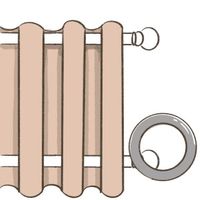 Grommet Top Bottom
Grommet Top Bottom
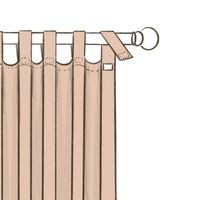 Velcro Tab Top
Velcro Tab Top
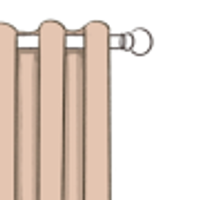 Grommet Top
Grommet Top
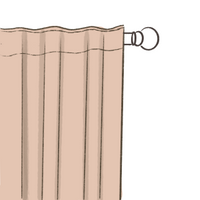 Back Tab & Rod Pocket
Back Tab & Rod Pocket
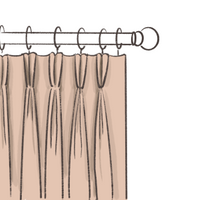 Double French Pinch Pleat
Double French Pinch Pleat
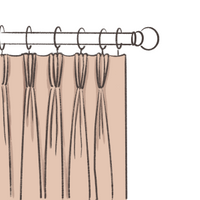 Triple French Pinch Pleat
Triple French Pinch Pleat
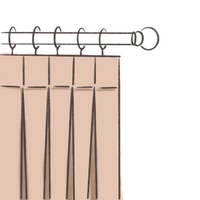 Inverted Box Pleat
Inverted Box Pleat
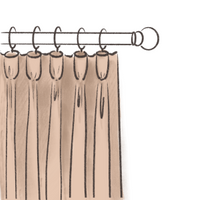 Goblet
Goblet
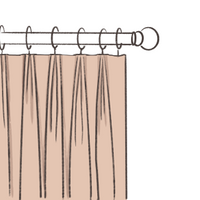 Euro Pleat
Euro Pleat
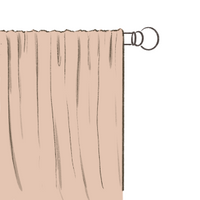 Single Rod Pocket
Single Rod Pocket
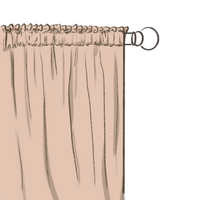 Double Rod Pockets
Double Rod Pockets
 Pleat Hook & Clip Rings
Pleat Hook & Clip Rings
 Pleat Hook
Pleat Hook
